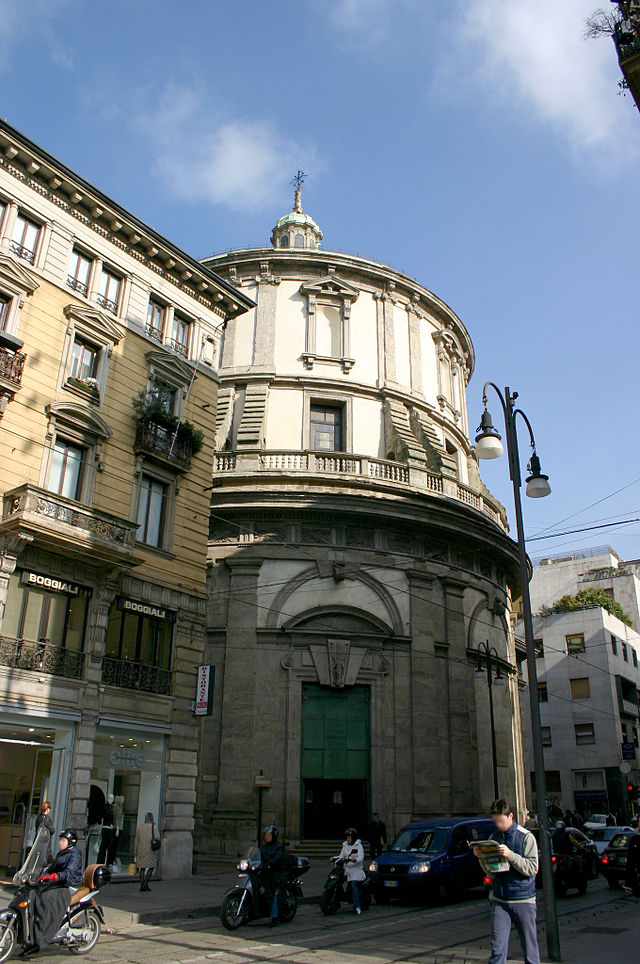Pellegrino Tibaldi
Italian architect and painter From Wikipedia, the free encyclopedia
Pellegrino Tibaldi (1527, Valsolda - 27 May 1596, Milan), also known as Pellegrino di Tibaldo de Pellegrini, was an Italian mannerist architect, sculptor, and mural painter.
Pellegrino Tibaldi | |
|---|---|
 Posthumous engraving of Tibaldi, 1762 | |
| Born | 1527 Puria di Valsolda, Como, Italy |
| Died | 1596 (aged 68–69) |
| Known for | Painting |
| Movement | Mannerism |

Biography
Summarize
Perspective
Tibaldi was born in Puria di Valsolda, then part of the duchy of Milan, but grew up in Bologna. His father worked as stonemason. He may have apprenticed with Bagnacavallo or Innocenzo da Imola. His first documented painting was likely as at 15 years of age, a Marriage of Saint Catherine.
In 1547, he went to Rome to study under Perin del Vaga. He was employed in the decoration of the Sala del Consiglio of Castel Sant'Angelo. When Perino died in 1547, Tibaldi became the leader in the large-scale fresco painting of the chambers and doorways (1547–1549). The frescoes are described as Michelangelesque in influence.
Other works were for Cardinal Giovanni Poggi in Bologna, and he carried out numerous commissions for him. Tibaldi painted frescoes of the Story of Ulysses in the Palazzo Poggi, scenes from the life of the Baptist in the Poggi chapel, and scenes from the Life of Moses in the Palazzo Sacchetti in Rome. He constructed a chapel for his patron, in the church of S. Giacomo Maggiore, and painted for it a St. John preaching in the Wilderness, and the Division of the Elect from the Damned. The Cardinal Poggi next employed him in the erection of a chapel in the Basilica della Santa Casa, Loreto, where he painted the Nativity, the Presentation in the Temple, the Transfiguration and Decollation of St. John.
He lived in Ancona between 1558 and 1561. Here he painted frescoes for Loggia dei Mercanti[1] and Palazzo Ferretti. In 1561, he met Cardinal Carlo Borromeo, who employed him in Milan mostly as architect in the nearly endless task of constructing the cathedral, working on various projects in the cathedral, the courtyard of the archiepiscopal palace (1564–70), San Fedele (1569–1579) and San Sebastiano (1577). In Milan he worked also as a civil architect, projecting the Spinola, Erba Odescalchi and Prospero Visconti palaces. In 1575 he was commissioned by Cardinal Tolomeo Gallio the construction of Villa d'Este on the shores of Lake Como. In Pavia, again for Cardinal Charles Borromeo, Tibaldi designed the monumental building of the Almo Collegio Borromeo: a university boarding school set on an airy courtyard with a perfect quadrature, characterized by the elegant Serlian architectural design of the two orders of loggias.[2] Also in Pavia, commissioned by Pope Pius V, Tibaldi was entrusted with the construction of the Collegio Ghislieri in 1567. Following the severe and ascetic character of the Counter-Reformation Pope, who had wanted a functional but not sumptuous construction for his college, Tibaldi interpreted this approach of the client by creating a three-storey building, with a square plan, imposing but not empty scenographic, with internal spaces functional to the community life that takes place there.[3]

In 1586 he went to Spain, where he followed and replaced Federico Zuccari as main court painter. He painted in the lower cloisters of El Escorial at the request of King Philip II. His greatest work were frescoes in the library. After nine years, he returned to Italy and was appointed architect of the Duomo of Milan until his death in Milan in 1592.
Pellegrino's brother, Domenico Tibaldi was a painter and architect active in Bologna. Among his pupils were Orazio Samacchini,[4] Lorenzo Sabbatini,[5] and Girolamo Miruoli.[6]
Partial anthology of works
- Marriage of Saint Catherine – Pinacoteca, Bologna
- St Michael fresco – Castel Sant'Angelo, Rome
- The Adoration of Christ by Shepherds – Galleria Borghese, Rome
- Conception of John the Baptist (1555) – San Giorgio Maggiore, Bologna
- Preaching to the Multitude, (San Giorgio Maggiore, Bologna)
- Holy Family and Saint John the Baptist (attributed) – Indianapolis Museum of Art
- Baptism of Christ – Ancona
- Altarpiece – Sant'Agostino, Ancona
- Incredulity of Thomas (1565) – drawing, 1565, Ambrosiana, Milan
- The Incredulity of Thomas (recto); Study for the Figure of Thomas (verso) – drawing, Getty Museum
- The Beheading of St. John the Baptist – Pinacoteca di Brera, Milan
- Madonna and Child – Private collection
- Holy Family and Holy Elizabeth
- Allegory of Silence (1569) – Museo Civico, Bologna
- Blinding of Polyphemus – Palazzo Sanguinetti
- Life of the Virgin – Escorial, Madrid
- Passion of Christ – Escorial, Madrid
- Ecce Homo (1589) – El Escorial, Madrid
- St. Michael – El Escorial, Madrid
- Martyrdom of St. Lawrence – Escorial, Madrid
- "Story of Joseph" Montreal Museum of Fine Arts, Montreal, Canada
References
External links
Wikiwand - on
Seamless Wikipedia browsing. On steroids.
